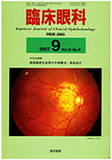Japanese
English
- 有料閲覧
- Abstract 文献概要
- 1ページ目 Look Inside
眼窩海綿状血管腫4例における画像所見の特徴について検討した。MRI所見において腫瘍の占拠部位は筋円錐内,筋円錐外が各々2例ずつであった。腫瘍の形は全例が境界明瞭な楕円形を示し,内部陰影は均一であり,T1強調画像で外眼筋と等信号,T2強調画像で脂肪より高信号を示した。DynamicMRIを施行した2例ではいずれも造影剤が流出血管との結合部と思われる点から徐々に拡散する濃染遅延像を示した。また超音波検査を施行した2例ではいずれも,Aモードによって“honeycomb”パターンを示し,septumで隔たれた多数の小血管腔からなる組織学的特徴を反映していることが示唆された。これらの画像所見は極めて特徴的であり,眼窩海綿状血管腫と他の眼窩腫瘍との鑑別上重要な所見と思われた。
We reviewed four cases of histologically confirmed orbital cavernous hemangioma. By magnetic resonance imaging (MRI) , the lesion was located within and out of the muscular cone in 2 cases each. The masses were ovoid, smooth-contoured and had sharply demarcated borders in all the cases. On T1-weighted images, the masses were homogeneously isointense with the extraocular muscles. On T2-weighted images, they were of high signal intensity relative to the orbital fat. Serial dynamic MR imaging after intravenous injection of Gd-DTPA showed enhancement of the site of entrance of feeder vessels appearing as a small point during the early phase. Delayed postcontrast images showed diffuse enhancement with gradual pooling of the contrast media within the masses. A-scan ultrasonography showed a honeycomb pattern of the masses, suggesting internal reflectivity from the septa between the vascular channels in the masses. The findings show the usefulness of MR imaging and ultrasonography in the differential diagnosis from other orbital tumors.

Copyright © 1997, Igaku-Shoin Ltd. All rights reserved.


